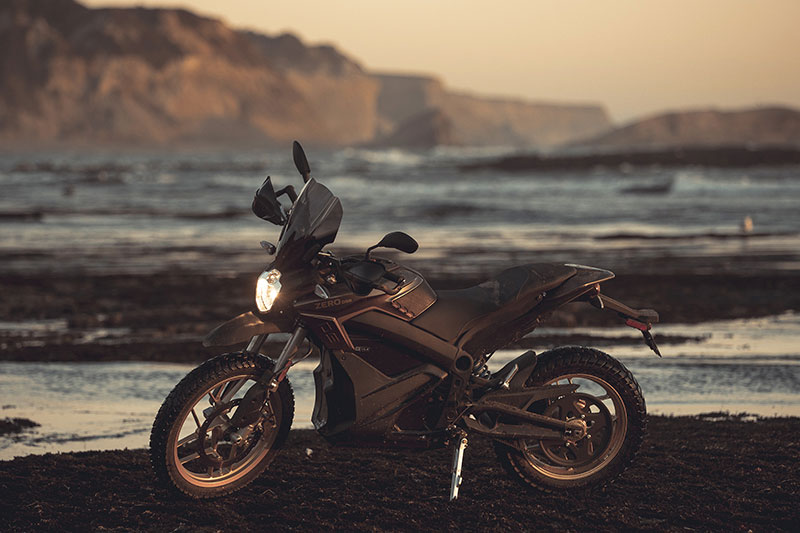2019 Zero DSR

First Ride Review
Sometimes, I can be such a sucker. Apparently, the good folks at Zero Motorcycles know this and jumped on my weakness. While unveiling the 2019 DSR dual-sport electric motorcycle in Santa Cruz, California, the Zero reps set the hook and reeled me in. Following the tech presentation they explained, “…and after the street portion of the ride we’ll ride off-road at a private ranch that we’ll have all to ourselves–dirt roads, unimproved roads, water crossings, a beach-riding photo op and some single-track too.”
What??? In my younger years I spent lots of time riding motorcycles around this very same area, decades ago before much of the land became fenced and gated. So I had a good idea about the mix of redwoods, bay laurel trees, ferns and banana slugs we’d see. Sold! I was all in and ready to roll.
Regarding electric vehicles, some cite concerns about limited range and hassles with recharging battery packs. That’s legit to a point, but the Zero engineers continue to notch advancements by tapping into new battery chemistry, advanced magnet composition, better firmware and redesign of the motor controller for more efficient yet more powerful motors, increased long-term charge storage and more. Claimed horsepower increases from 67 on the DSR we reviewed in 2016 to 70 on the new model, and torque jumps from 106 lb-ft to a whopping 116 lb-ft—that’s more grunt than the most powerful 1,000cc sportbike in production today, as the Zero reps love to explain, and the controller delivers it very smoothly and quickly.
Given increased range claims of 163 miles in the city and 78 miles on the highway, even this new and improved iteration still offers a radically different performance envelope compared to internal-combustion machines. So the key is to clearly identify and stay within the working envelope. Specifically, Zeros can work very well for commuting (especially if you can recharge your bike while at work or school), and in the case of the DSR, it would be grand to have one on hand for riding out from a mountain cabin.
On pavement the street-biased DSR feels agile like a sporting 600cc bike in terms of weight and size–albeit one with monster torque. Much of its weight is carried low, which makes it feel even lighter and more nimble than its claimed 416-pound curb weight would suggest. Yet the instant-on torque rockets you out of corners, setting the front end to skipping over the pavement if you’re not careful. The wide handlebar lends leverage for steering input and you can slice and dice your favorite back road right into bite-sized pieces thanks to the stout aluminum frame and high-quality fully adjustable Showa suspension.
I got caught out on the fast-paced first corner; set on Sport mode, the Zero returns little regenerative “engine” braking when you roll off the throttle–surprise! Luckily, my old two-stroke reflexes kicked in and I just squeezed harder on the lever for the single-disc front brake. Off-road, braking power is less of an issue than tire traction; the hybrid Pirelli MT-60s strike a good compromise for street and dirt use, but of course they can’t match the grip of full-on knobby tires when riding on the loose stuff.
The DSR’s riding position feels open and comfortable, with a fairly broad and sufficiently padded seat, though the passenger step restricts rider movement a bit. The handlebar sits a tad too low for this six-footer while standing on the pegs, but the nice, wide footpegs are dual-sport comfortable.
In the dirt, managing the strong initial power onset can be a little tricky. But with practice it becomes simple to modulate power while negotiating tight spaces, especially if you ramp down to the Eco setting that restricts power delivery. (There’s also a Custom setting for adjusting power and regen to your liking.) Once you get the hang of it, negotiating tight quarters on heavily wooded trails becomes a joy since no clutch skills are needed–one less thing to distract you from the task of actually riding the bike.
In keeping with dual-sport and ADV bike trends, the DSR now comes equipped with a modestly sized windscreen, grippy tank panels for off-road, up-on-the-pegs riding, hand guards and a handy 12-volt accessory socket–all at no added cost over last year’s MSRP of $16,495. That adds measurably to the utility and versatility quotients. Also, the decent-sized “tank top” storage compartment is handy if you don’t install Zero’s accessory extra battery (Power Tank) or fast-charge (Charge Tank) setup.
Adapting to any vehicle takes some effort as you work to its strengths and cover its weak spots. We already do that when we jump back and forth from four wheels to two, so it’s just another parallel path when we jump from internal combustion to electric bikes. In summary, it’s not about the DSR’s limitations; it’s about how well it actually works as a motorcycle in a variety of settings. And as this short first ride proved, the 2019 Zero DSR can work very well indeed as a capable and versatile dual-sport machine.
